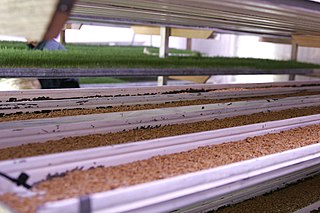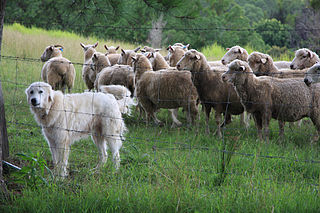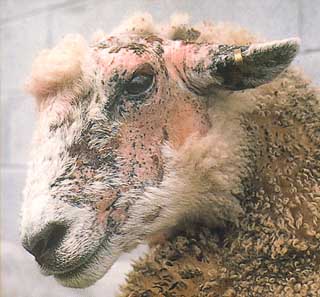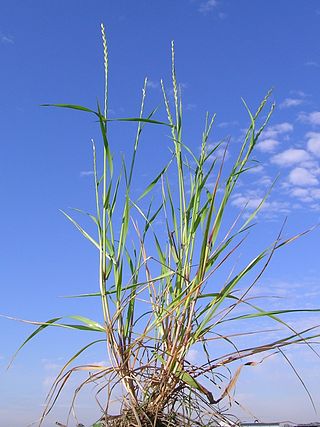Related Research Articles

Hay is grass, legumes, or other herbaceous plants that have been cut and dried to be stored for use as animal fodder, either for large grazing animals raised as livestock, such as cattle, horses, goats, and sheep, or for smaller domesticated animals such as rabbits and guinea pigs. Pigs can eat hay, but do not digest it as efficiently as herbivores do.

Herbicides, also commonly known as weed killers, are substances used to control undesired plants, also known as weeds. Selective herbicides control specific weed species while leaving the desired crop relatively unharmed, while non-selective herbicides kill plants indiscriminately. The combined effects of herbicides, nitrogen fertilizer, and improved cultivars has increased yields of major crops by three to six times from 1900 to 2000.

Toxicity is the degree to which a chemical substance or a particular mixture of substances can damage an organism. Toxicity can refer to the effect on a whole organism, such as an animal, bacterium, or plant, as well as the effect on a substructure of the organism, such as a cell (cytotoxicity) or an organ such as the liver (hepatotoxicity). Sometimes the word is more or less synonymous with poisoning in everyday usage.

Weed control is a type of pest control, which attempts to stop or reduce growth of weeds, especially noxious weeds, with the aim of reducing their competition with desired flora and fauna including domesticated plants and livestock, and in natural settings preventing non native species competing with native species.
Locoweed is a common name in North America for any plant that produces swainsonine, an alkaloid harmful to livestock. Worldwide, swainsonine is produced by a small number of species, most of them in three genera of the flowering plant family Fabaceae: Oxytropis and Astragalus in North America, and Swainsona in Australia. The term locoweed usually refers only to the North American species of Oxytropis and Astragalus, but this article includes the other species as well. Some references may incorrectly list Datura as locoweed.

Foodborne illness is any illness resulting from the contamination of food by pathogenic bacteria, viruses, or parasites, as well as prions, and toxins such as aflatoxins in peanuts, poisonous mushrooms, and various species of beans that have not been boiled for at least 10 minutes.

Fodder, also called provender, is any agricultural foodstuff used specifically to feed domesticated livestock, such as cattle, rabbits, sheep, horses, chickens and pigs. "Fodder" refers particularly to food given to the animals, rather than that which they forage for themselves. Fodder includes hay, straw, silage, compressed and pelleted feeds, oils and mixed rations, and sprouted grains and legumes. Most animal feed is from plants, but some manufacturers add ingredients to processed feeds that are of animal origin.

The Shropshire breed of domestic sheep originated from the hills of Shropshire, and North Staffordshire, England, during the 1840s. The breeders in the area used the local horned black-faced sheep and crossed them with a few breeds of white-faced sheep. This produced a medium-sized polled (hornless) sheep that produced good wool and meat. In 1855 the first Shropshires were imported into the United States (Virginia). This breed is raised primarily for meat.
Lidophia graminis, twist fungus, is a fungus found in southern Australia, the Middle East and Europe. Recent research by scientists from Western Australia has found the fungus is capable of controlling organisms that cause the disease of livestock known as annual ryegrass toxicity. An inoculum of the fungus was developed.

Anguina agrostis is a plant pathogenic nematode.

A livestock guardian dog (LGD) is a dog type bred for the purpose of protecting livestock from predators.

Facial eczema is a mycotoxic disease that affects the liver of several animals, mainly sheep and cattle, but can also infect other ungulates. It is caused by ingesting sporidesmins released by the fungus Pithomyces chartarum. Its visible symptoms are characterized by red skin that turns black and crusty before peeling off, as well as inflammation that can cause swelling of the udder, teats, ears and face. The disease is not always visible. Other symptoms include weight loss, weakness and death.

A harmful algal bloom (HAB), or excessive algae growth, is an algal bloom that causes negative impacts to other organisms by production of natural algae-produced toxins, water deoxygenation, mechanical damage to other organisms, or by other means. HABs are sometimes defined as only those algal blooms that produce toxins, and sometimes as any algal bloom that can result in severely lower oxygen levels in natural waters, killing organisms in marine or fresh waters. Blooms can last from a few days to many months. After the bloom dies, the microbes that decompose the dead algae use up more of the oxygen, generating a "dead zone" which can cause fish die-offs. When these zones cover a large area for an extended period of time, neither fish nor plants are able to survive. Harmful algal blooms in marine environments are often called "red tides".

Slaframine is an bicyclic alkaloid mycotoxin that causes salivation (slobbers) in most animals. It is usually produced by the fungus Rhizoctonia leguminicola which is a common fungal pathogen of red clover (Trifolium pratense) that causes black patch disease in the plant. Slaframine has the molecular formula C10H18N2O2. Wet and humid weather are the favorable environmental condition for the growth of the fungus and production of slaframine. Legume hays contaminated with slaframine cause slobber syndrome and various animals are sensitive to its effects.
Rathayibacter toxicus is a phytopathogenic bacterium known for causing annual ryegrass toxicity (ARGT) commonly found in South and Western Australia.

Lolium rigidum is a species of annual grass. Common names by which it is known include annual ryegrass, a name also given to Italian ryegrass, rigid ryegrass, stiff darnel, Swiss ryegrass and Wimmera ryegrass. It is a native of southern Europe, northern Africa, the Middle East and the Indian subcontinent and is grown as a forage crop, particularly in Australia, where it is also a serious and economically damaging crop weed.
Perennial ryegrass staggers is poisoning by peramine, lolitrem B, and other toxins that are contained in perennial ryegrass, and produced by the endophyte fungus Epichloë festucae which can be present in all parts of the grass plant, but tends to be concentrated in the lower part of the leaf sheaths, the flower stalks and seeds. This condition can affect horses, cattle, sheep, farmed deer and llamas. It regularly occurs in New Zealand and is known spasmodically from Australia, North and South America, and Europe.

Lolitrem B is one of many toxins produced by a fungus called Epichloë festucae var. lolii), which grows in Lolium perenne. The fungus is symbiotic with the ryegrass; it doesn't harm the plant, and the toxins it produces kill insects that feed on ryegrass. Lolitrem B is one of these toxins, but it is also harmful to mammals. The shoots and flowers of infected ryegrass have especially high concentrations of lolitrem B, and when livestock eat too much of them, they get perennial ryegrass staggers. At low doses the animals have tremors, and at higher doses they stagger, and at higher yet doses the animals become paralyzed and die. The blood pressure of the animals also goes up. The effect of the lolitrem B comes on slowly and fades out slowly, as it is stored in fat after the ryegrass is eaten. The condition is especially common in New Zealand and Australia, and plant breeders there have been trying to develop strains of fungus that produce toxins only harmful to pests, and not to mammals.

Vaccinations for cattle involves the process of applying subcutaneous injections of biological microorganisms in a weakened state to help the immune system develop protection by providing active acquirement of immunity to a particular disease. Cattle are bovine livestock and are thus very susceptible to diseases. Vaccinations for cattle are widely used in the livestock industries of the Australian agriculture sector by farmers to prevent harmful and deadly diseases from infecting their livestock, avoiding any economical or biological harm. Farmed livestock industries account for 45% of the gross value of Australian agricultural output, beef cattle being the largest farmed livestock nationally with around 26.2 million head of cattle nationwide. The beef industry within Australia generates a gross value of approximately $8 billion AUD in beef exports and a total gross value of $11.4 billion in farm production (2017–18). Thus, vaccinations play a vital role in protecting, sustaining and growing the beef cattle industry in the Australian agriculture sector.

Quizalofop is a chlorophenxy and phenoxy herbicide that works by inhibition of acetyl-CoA-carboxylase to selectively control grasses, without affecting broadleaf crops. It may be shortened to QPE, from Quizalofop-P-Ethyl. It is a Group 1 / A / A herbicide, used in Australia, Morocco and Europe.
References
- ↑ Simpson, Wayne (1 August 2013). "Annual ryegrass staggers". Merck. Archived from the original on 11 December 2015. Retrieved 9 December 2015.
- ↑ "Annual ryegrass toxicity". SheepConnect. Retrieved 9 December 2015.